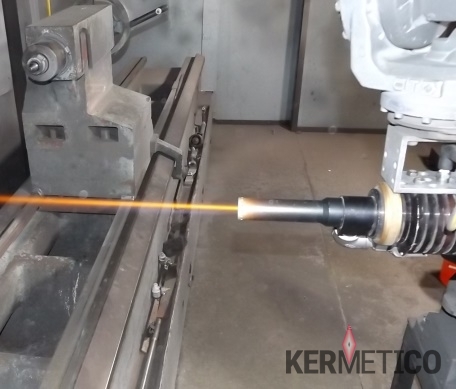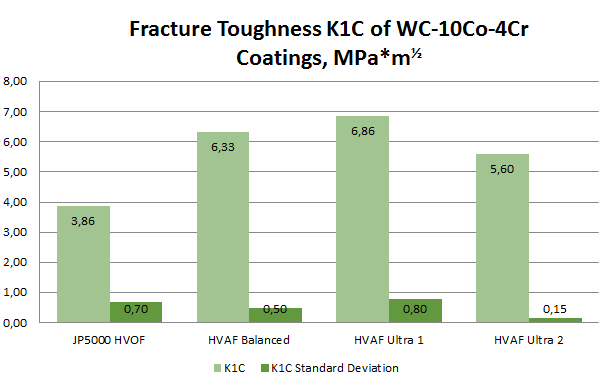Corrosion, Erosion, And Abrasion Resistant HVAF Coating Material Selection
Depositing the same feedstock using different technologies results in different coating properties.
The Kermetico HVAF process lets you spray well-known materials with more desirable properties: higher hardness, ductility and deposition efficiency, with lower porosity and cost.
Take a look at the properties of our excellent carbide, metal and alloyed coatings.
The Task Of Material Choice For A Protective Coating
What are we looking for when choosing a coating material for the thermal spray process?
- Hardness
- Ductility
- Gas permeability (find out here how we test it)
- Fracture toughness
- Corrosion resistance in the given environment
- Tribological properties in contact with a given material
- Electrical conductivity
- Bond strength
- Coefficient of thermal expansion
- Residual stress
- Porosity
- Spray rate
- Deposition efficiency
- Cost of the feedstock spray material
- Cost of the applied coating
This is the way we proceed to get the best lifecycle cost for a given part or machine.
This method is not particularly simple, and the limitations of the process don’t make it any easier, as each thermal spray coating system has its limitations.
We have developed and use our innovative HVAF thermal spray systems breaking through many of the limits of traditional thermal spray processes. We have also designed and built systems for a particular material application to achieve optimal results.
The Properties Of A Typical Kermetico HVAF Coating
The Kermetico HVAF Process: High Power, Narrow Powder Jet
Traditional thermal spray processes are based on this principle: heat fast – spray fast, the idea being that the faster we execute the process – the less oxidation we will have, the better coating we will get. Sometimes it works. Herewith, fast heating requires higher gas temperatures, which may cause quite the opposite results: material evaporation, higher oxidation levels and coating material degradation.
While we are developing Kermetico HVAF equipment, we continuously keep to one principle: heat slow, spray fast. A large diameter combustion chamber and a comparatively low gas combustion temperature allow us to deliver powder materials axially, directly to the combustion zone, where they are heated gradually and evenly.
Our guns have a large diameter, flow optimized nozzle and narrow powder jet and these factors minimize any nozzle wall influence on particle velocity. Multiple gun designs and configurations let us spray materials with different melting points without overheating them.
The Bond Strength Of HVAF Coatings: Weld Through the Coating
Due to the high-velocity impact of the spray particles, Kermetico HVAF coatings provide high bond strength to metallic substrates and exhibit excellent cohesion strength.
Some Kermetico HVAF metallic coatings can withstand impacts by a hammer or welding through the coating without cracking or delamination.
Kermetico HVAF Metal Coating’s Resistance To High Temperature Corrosion
The absence of oxide scales and the high density of Kermetico HVAF coatings results in their superior performance in high temperature corrosion environments.
In oxidizing and sulfurizing environments HVAF coatings of alloy 625 and alloy 671 substantially outperformed their counterparts sprayed with electric arc or HVOF coatings.
The beneficial factor was that HVAF metal coatings efficiently sintered and formed diffusion zones with a substrate at elevated temperatures, afterward performing as a “solid metal.”
Such sintering and inter-diffusion are restricted in other thermal spray coatings because oxide scales are efficient barriers to diffusion.
The Fracture Toughness Of HVAF Coatings
Kermetico HVAF coatings reveal excellent crack resistance (fracture toughness). One of the methods for measuring the fracture toughness coefficient, K1C, for brittle materials involves indentation with a Vickers pyramid and measuring of induced crack length. Since K1C ~ (a/c)3/2, when a>c (a is the diagonal of the indentation, c is the length of the induced crack), the ratio “a/c” can be used as the crack resistance factor. In our tests, the crack resistance factor was found to be between 3 and 4 for different HVOF coatings of WC-based materials. Corresponding Kermetico HVAF coatings revealed values between 5 and 7, indicating substantially improved crack resistance.
In addition to improved coating performance, this fact has very practical applications in the creation of new markets for HVAF thermal spray coatings. In particular, improved coating crack resistance results in the possibility of applying very thick layers of carbides, using carbide coatings to combat cavitation, applying coatings on parts working in conditions of alternating stresses, impact, etc.





